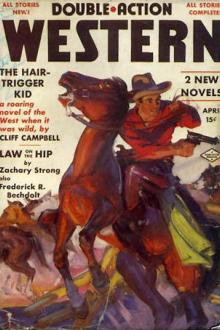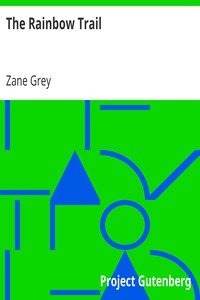The Light of the Western Stars, Zane Grey [e reader pdf best .TXT] 📗

- Author: Zane Grey
Book online «The Light of the Western Stars, Zane Grey [e reader pdf best .TXT] 📗». Author Zane Grey
“Indeed he shall,” replied Madeline. “But tell me, please, all about the round-up.”
“Well, in the first place, every cattleman has to have a brand to identify his stock. Without it no cattleman, nor half a hundred cowboys, if he had so many, could ever recognize all the cattle in a big herd. There are no fences on our ranges. They are all open to everybody. Some day I hope we'll be rich enough to fence a range. The different herds graze together. Every calf has to be caught, if possible, and branded with the mark of its mother. That's no easy job. A maverick is an unbranded calf that has been weaned and shifts for itself. The maverick then belongs to the man who finds it and brands it. These little calves that lose their mothers sure have a cruel time of it. Many of them die. Then the coyotes and wolves and lions prey on them. Every year we have two big round-ups, but the boys do some branding all the year. A calf should be branded as soon as it's found. This is a safeguard against cattle-thieves. We don't have the rustling of herds and bunches of cattle like we used to. But there's always the calf-thief, and always will be as long as there's cattle-raising. The thieves have a good many cunning tricks. They kill the calf's mother or slit the calf's tongue so it can't suck and so loses its mother. They steal and hide a calf and watch it till it's big enough to fare for itself, and then brand it. They make imperfect brands and finish them at a later time.
“We have our big round-up in the fall, when there's plenty of grass and water, and all the riding-stock as well as the cattle are in fine shape. The cattlemen in the valley meet with their cowboys and drive in all the cattle they can find. Then they brand and cut out each man's herd and drive it toward home. Then they go on up or down the valley, make another camp, and drive in more cattle. It takes weeks. There are so many Greasers with little bands of stock, and they are crafty and greedy. Bill says he knows Greaser cowboys, vaqueros, who never owned a steer or a cow, and now they've got growing herds. The same might be said of more than one white cowboy. But there's not as much of that as there used to be.”
“And the horses? I want to know about them,” said Madeline, when Florence paused.
“Oh, the cow-ponies! Well, they sure are interesting. Broncos, the boys call them. Wild! they're wilder than the steers they have to chase. Bill's got broncos heah that never have been broken and never will be. And not every boy can ride them, either. The vaqueros have the finest horses. Don Carlos has a black that I'd give anything to own. And he has other fine stock. Gene Stewart's big roan is a Mexican horse, the swiftest and proudest I ever saw. I was up on him once and—oh, he can run! He likes a woman, too, and that's sure something I want in a horse. I heard Al and Bill talking at breakfast about a horse for you. They were wrangling. Bill wanted you to have one, and Al another. It was funny to hear them. Finally they left the choice to me, until the round-up is over. Then I suppose every cowboy on the range will offer you his best mount. Come, let's go out to the corrals and look over the few horses left.”
For Madeline the morning hours flew by, with a goodly part of the time spent on the porch gazing out over that ever-changing vista. At noon a teamster drove up with her trunks. Then while Florence helped the Mexican woman get lunch Madeline unpacked part of her effects and got out things for which she would have immediate need. After lunch she changed her dress for a riding-habit and, going outside, found Florence waiting with the horses.
The Western girl's clear eyes seemed to take stock of Madeline's appearance in one swift, inquisitive glance and then shone with pleasure.
“You sure look—you're a picture, Miss Hammond. That riding-outfit is a new one. What it 'd look like on me or another woman I can't imagine, but on you it's—it's stunning. Bill won't let you go within a mile of the cowboys. If they see you that'll be the finish of the round-up.”
While they rode down the slope Florence talked about the open ranges of New Mexico and Arizona.
“Water is scarce,” she said. “If Bill could afford to pipe water down from the mountains he'd have the finest ranch in the valley.”
She went on to tell that the climate was mild in winter and hot in summer. Warm, sunshiny days prevailed nearly all the year round. Some summers it rained, and occasionally there would be a dry year, the dreaded ano seco of the Mexicans. Rain was always expected and prayed for in the midsummer months, and when it came the grama-grass sprang up, making the valleys green from mountain to mountain. The intersecting valleys, ranging between the long slope of foothills, afforded the best pasture for cattle, and these were jealously sought by the Mexicans who had only small herds to look after. Stillwell's cowboys were always chasing these vaqueros off land that belonged to Stillwell. He owned twenty thousand acres of unfenced land adjoining the open range. Don Carlos possessed more acreage than that, and his cattle were always mingling with Stillwell's. And in turn Don Carlos's vaqueros were always chasing Stillwell's cattle away from the Mexican's watering-place. Bad feeling had been manifested for years, and now relations were strained to the breaking-point.
As Madeline rode along she made good use of her eyes. The soil was sandy and porous, and she understood why the rain and water from the few springs disappeared so quickly. At a little distance the grama-grass appeared thick, but near at hand it was seen to be sparse. Bunches of greasewood and cactus plants were interspersed here and there in the grass. What surprised Madeline was the fact that, though she and Florence had seemed to be riding quite awhile, they had apparently not drawn any closer to the round-up. The slope of the valley was noticeable only after some miles had been traversed. Looking forward, Madeline imagined the valley only a few miles wide. She would have been sure she could walk her horse across it in an hour. Yet that black, bold range of Chiricahua Mountains was distant a long day's journey for even a hard-riding cowboy. It was only by looking back that Madeline could grasp the true relation of things; she could not be deceived by distance she had covered.
Gradually the black dots enlarged and assumed shape of cattle and horses moving round a great dusty patch. In another half-hour Madeline rode behind Florence to the outskirts of the scene of action. They drew rein near a huge wagon in the neighborhood of which were more than a hundred horses grazing and whistling and trotting about and lifting heads to watch the new-comers. Four cowboys stood mounted guard over this drove of horses. Perhaps a quarter of a mile farther out was a dusty melee. A roar of tramping hoofs filled Madeline's ears. The lines of marching cattle had merged into a great, moving herd half obscured by dust.
“I can make little of what is going on,” said Madeline. “I want to go closer.”
They trotted across half the intervening distance, and when Florence halted again Madeline was still not satisfied and asked to be taken nearer. This time, before they reined in again, Al Hammond saw them and wheeled





Comments (0)